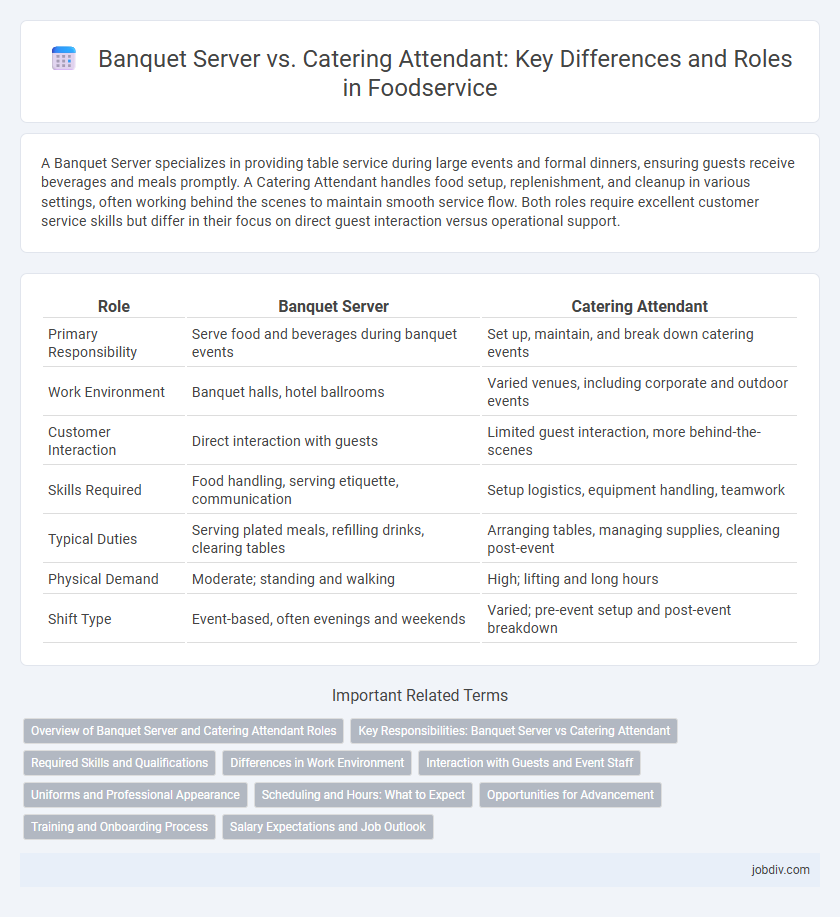A Banquet Server specializes in providing table service during large events and formal dinners, ensuring guests receive beverages and meals promptly. A Catering Attendant handles food setup, replenishment, and cleanup in various settings, often working behind the scenes to maintain smooth service flow. Both roles require excellent customer service skills but differ in their focus on direct guest interaction versus operational support.
Table of Comparison
| Role | Banquet Server | Catering Attendant |
|---|---|---|
| Primary Responsibility | Serve food and beverages during banquet events | Set up, maintain, and break down catering events |
| Work Environment | Banquet halls, hotel ballrooms | Varied venues, including corporate and outdoor events |
| Customer Interaction | Direct interaction with guests | Limited guest interaction, more behind-the-scenes |
| Skills Required | Food handling, serving etiquette, communication | Setup logistics, equipment handling, teamwork |
| Typical Duties | Serving plated meals, refilling drinks, clearing tables | Arranging tables, managing supplies, cleaning post-event |
| Physical Demand | Moderate; standing and walking | High; lifting and long hours |
| Shift Type | Event-based, often evenings and weekends | Varied; pre-event setup and post-event breakdown |
Overview of Banquet Server and Catering Attendant Roles
Banquet servers specialize in providing table service during formal events, ensuring guests receive food and beverages promptly while maintaining a polished and professional presentation. Catering attendants handle the setup, replenishment, and breakdown of food service stations at various functions, facilitating smooth operation and guest satisfaction. Both roles require strong customer service skills but differ in their focus on direct guest interaction versus logistical support.
Key Responsibilities: Banquet Server vs Catering Attendant
Banquet servers primarily manage food and beverage service during events, ensuring timely delivery, table setup, and guest satisfaction in banquet halls or hotel ballrooms. Catering attendants focus on event setup, including arranging food stations, handling pre-event preparations, and breaking down equipment post-event, often working at off-site locations. Both roles require excellent customer service skills but differ in scope, with banquet servers emphasizing front-of-house service and catering attendants managing logistical and operational tasks behind the scenes.
Required Skills and Qualifications
Banquet servers require strong interpersonal skills, attention to detail, and the ability to manage high-volume food and beverage service during events. Catering attendants must possess excellent organizational skills, physical stamina for setup and breakdown tasks, and knowledge of food safety regulations. Both roles demand effective communication, teamwork, and customer service expertise to ensure seamless event execution.
Differences in Work Environment
Banquet servers primarily work in formal event settings such as hotels and banquet halls, where they serve plated meals and handle guest service during scheduled events. Catering attendants often operate in more varied environments, including corporate offices, outdoor venues, and private homes, assisting with food setup, replenishment, and breakdown. The banquet server role emphasizes direct guest interaction and polished presentation, while the catering attendant focuses on logistical support and adaptability to diverse locations.
Interaction with Guests and Event Staff
Banquet servers maintain direct interaction with guests by promptly addressing their dining needs and ensuring a seamless experience during the event. Catering attendants collaborate closely with event staff, focusing on setup, service flow, and behind-the-scenes coordination to support overall event efficiency. Both roles require strong communication skills but differ in guest engagement levels, with banquet servers having more face-to-face guest interaction.
Uniforms and Professional Appearance
Banquet servers typically wear formal uniforms such as black trousers, white dress shirts, and vests or jackets to match the upscale venue ambiance, emphasizing a polished and elegant appearance. Catering attendants often don more versatile attire, including branded polo shirts or dress shirts paired with slacks, designed for practicality and easy mobility during varied event setups. Both roles prioritize cleanliness and neatness to maintain a professional image, but banquet server uniforms lean towards classic sophistication while catering attendant attire balances professionalism with functionality.
Scheduling and Hours: What to Expect
Banquet servers typically work during large, scheduled events with fixed hours, often requiring availability for evenings and weekends due to the nature of social gatherings and corporate functions. Catering attendants experience more variable schedules, adjusting to event timelines that may include early mornings, late nights, and sometimes multiple events in a single day. Both roles demand flexibility, but banquet servers usually have more predictable hours tied to event bookings, while catering attendants must adapt to diverse and dynamic timeframes.
Opportunities for Advancement
Banquet servers often have clear pathways to supervisory roles or banquet management within hotels and event venues, leveraging their direct interaction with guests and event coordination skills. Catering attendants can advance by specializing in logistics and large-scale event planning, potentially moving into catering coordination or operations management. Both roles offer growth opportunities, but banquet servers may experience faster progression in client-facing leadership positions.
Training and Onboarding Process
Banquet servers undergo specialized training focused on formal dining service, table settings, and guest interaction protocols to ensure smooth banquet event execution. Catering attendants are trained in logistics, food handling, and setup/cleanup procedures tailored to various event types, emphasizing flexibility and efficiency. Onboarding for both roles includes safety standards and customer service skills but differs in operational focus, with banquet servers requiring refined service etiquette and catering attendants prioritizing event flow management.
Salary Expectations and Job Outlook
Banquet servers typically earn an average hourly wage ranging from $12 to $18, influenced by event type and location, while catering attendants may have similar pay scales but often receive additional tips during off-site events. The job outlook for both roles is promising, with the hospitality industry projected to grow 8% over the next decade, driven by increased demand for event-based foodservice. Catering attendants might experience more seasonal fluctuations compared to banquet servers, who generally benefit from steady employment in venues hosting frequent events.
Banquet Server vs Catering Attendant Infographic

 jobdiv.com
jobdiv.com